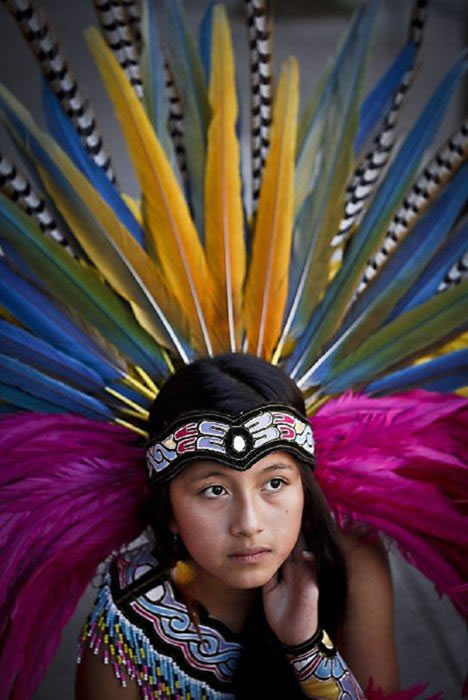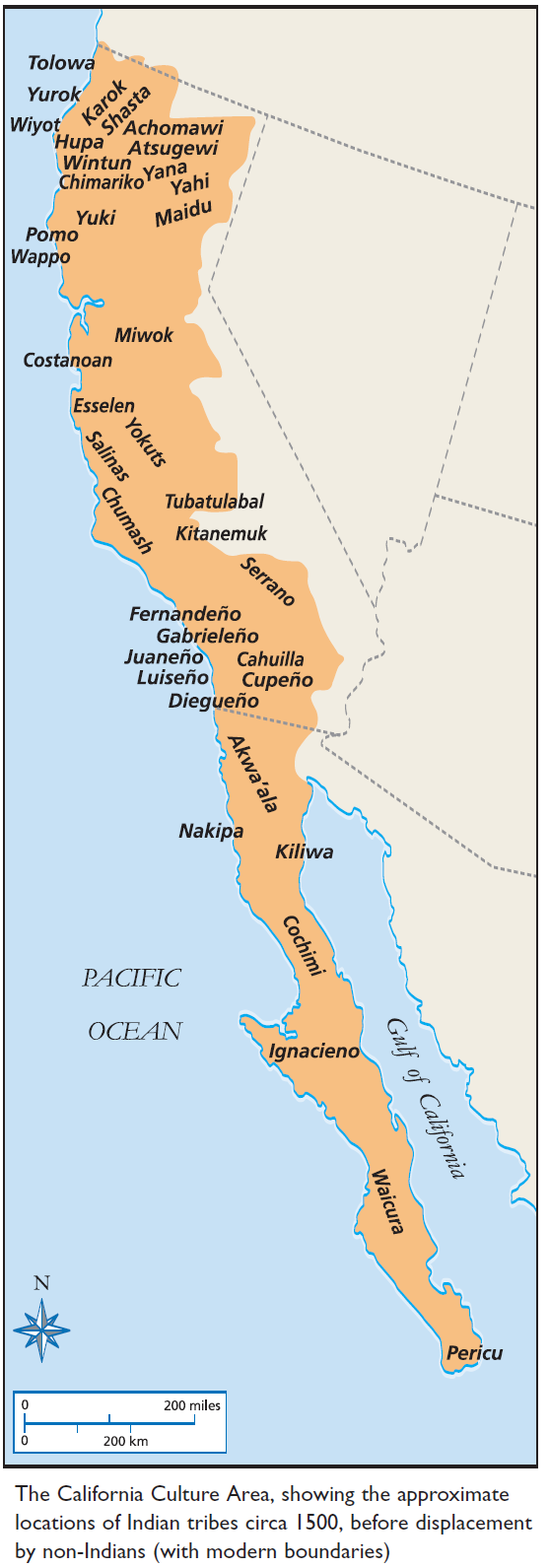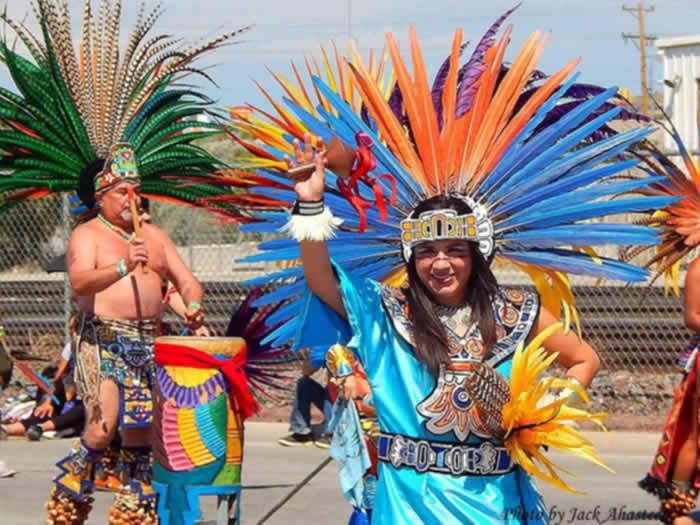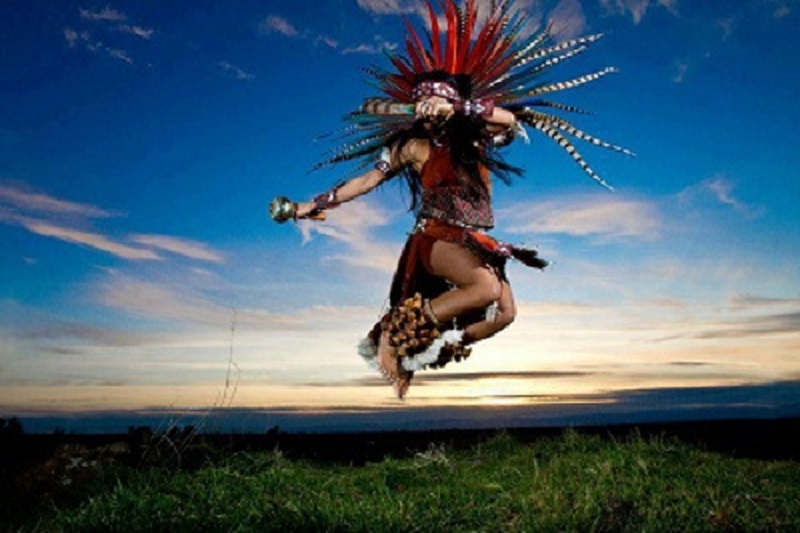The California Indians comprise diverse tribes within the California Culture Area, which includes the state of California and the Lower California Peninsula in Mexico. The Sierra Nevada mountain range acts as a natural barrier in the eastern region, causing some tribes to be categorized in the Great Basin and Southwest Culture Areas, while tribes near the California-Oregon border are included in the Northwest Coast and Plateau Culture Areas.
Within the California Culture Area, the smaller Coast Range runs north-south and the Great California Valley lies between the two mountain ranges, formed by the San Joaquin and Sacramento Rivers and their tributaries. The amount of rainfall varies greatly from north to south, with northern uplands receiving the most precipitation, resulting in tall forests. The south of the region is much drier, with the Mojave Desert near the California-Arizona border, and most coastal lowlands in Mexico being desert country.
Despite the varying climate, the California Culture Area offered abundant wild plant foods and game, allowing the California Indians to thrive as hunter-gatherers without the need for farming. Tobacco was the only cultivated crop found in the region.
There were many different California peoples, speaking
at least 100 distinct dialects. The main language
groups identified are the Athapascan language family
(part of the Na-Dene language phylum), the Hokan language
phylum, the Penutian language phylum, and the
Uto-Aztecan language family (part of the Aztec-Tanoan
language phylum).
Among the ATHAPASCANS, mostly in the north, are
the Bear River, Cahto (Kato), Chilula, HUPA, Lassik,
Mattole, Nongatl, Sinkyone, TOLOWA, Wailaki, and
Whilkut.
Among the Hokan tribes, speaking dialects of a number
of small language families or language isolates, are
the ACHOMAWI (PIT RIVER), Atsugewi, CHIMARIKO,
CHUMASH, ESSELEN, KAROK, Konomihu, New River
Indians, Okwanuchu, POMO, SALINAS, SHASTA, YAHI,
and Yana. The larger Yuman language family is also part
of the Hokan phylum. The Yuman-speaking tribes in the
culture area are Akwaala, DIEGUEÑO (TIPAI-IPAI),
Kamia, plust tribes to the south in Baja California, now
part of Mexico.
Among the Penutian tribes, speaking dialects of a
number of small language families, are COSTANOAN,
MAIDU, MIWOK, WINTUN, and YOKUTS.
Among the Uto-Aztecan-speaking tribes, mostly in
the south, are Alliklik (Tataviam), CAHUILLA, CUPEÑO, Fernandeño, GABRIELEÑO, Juaneño, Kitanemuk,
LUISEÑO, Nicoleño, Serrano, Tubatulabal, and
Vanyume. Many of these Uto-Aztecan peoples came to
be known historically as MISSION INDIANS.
 Other languages are identified in the California
Culture Area as well: dialects of Algonquian (Ritwan
subgroup), spoken by the Wiyot and YUROK, making
these peoples the westernmost ALGONQUIANS; and a
language family known as Yukian (of undetermined
phylum affiliation), spoken by the Huchnom, Wappo,
and YUKI.
Other languages are identified in the California
Culture Area as well: dialects of Algonquian (Ritwan
subgroup), spoken by the Wiyot and YUROK, making
these peoples the westernmost ALGONQUIANS; and a
language family known as Yukian (of undetermined
phylum affiliation), spoken by the Huchnom, Wappo,
and YUKI.
Food
The dietary staple of California Indians was the acorn,
the fruit of the oak tree. Native peoples collected them in
the fall. They removed the kernels from the shells, placed
them in the sun to dry out, pounded them into a flour,
then repeatedly poured hot water over the flour to
remove the bitter-tasting tannic acid. Then they boiled
the acorn meal into a soup or mush or baked it into a
bread. Other wild plant foods included berries, nuts,
seeds, greens, roots, bulbs, and tubers. Sun-dried berries,
roots, and seeds also were used to make cakes.
California Indians also ate insects. They picked grubs and caterpillars off plants. They boiled the caterpillars with salt, considering them a delicacy. They drove grasshoppers into pits, then roasted them. And they collected honeydew as another delicacy, rolling it into pellets. (Insects called aphids suck the juices of plants and secrete sweet-tasting honeydew.)
Rabbits were common throughout the culture area.
The Indians used snares and other kinds of traps to catch
them, as well as bows and arrows and clubs. In pursuit of
deer, California Indians journeyed into the hill country,
hunting with bows and arrows or herding them into corrals.
Waterfowl also provided meat. Ducks, geese, swans,
and other birds migrating from the north in the autumn
descended on the marshes. The Indians shot at them
from blinds with bows and arrows or bagged them from
boats with nets.
California Indians had many different methods of
fishing, including hooks and lines, spears, nets, and weirs
(enclosures). Lakes, rivers, and the sea offered their
catch. Along the seashore and in tidal basins, the Indians
also gathered clams, oysters, mussels, abalones, and scallops.
And they hunted seals and sea otters.
Houses
California Indians lived in many different kinds of houses.
The most typical house throughout the culture area was
cone-shaped, about eight feet in diameter at the base. It
was constructed from poles covered with brush, grass,
reeds, or mats of tule (a king of bulrush). Other kinds of
dwellings included domed earth-covered pithouses and
lean-tos of bark slabs. In the northern part of the culture
area, some Indians built wood plank houses more typical of
the NORTHWEST COAST INDIANS. Most of the California
houses served as single-family dwellings, but some were
communal or ceremonial. Others served as sweathouses.
Clothing in much of the region was minimal because of
the warm climate. Men often went completely naked or
wore simple animal-skin or bark breechcloths. Women
always wore at least fringed aprons in the front and back,
made from animal skins or shredded willow bark. After the
coming of non-Indians, cotton came to replace bark in
many instances. Headwear included basket hats, iris fiber
hairnets, feather headbands, and feather crowns. Some
California Indians went barefoot; others wore ankle-high
leather moccasins or sandals made from the yucca plant. In
cold weather, robes and blankets of rabbit skin, seaotter fur,
or feathers were draped over the shoulders. Shell jewelry
was widespread, as was the practice of tattooing.
Transportation
With regard to transportation, California Indians usually
traveled by foot. But they also had different kinds of
craft for transporting supplies by water. Some peoples,
such as the Yurok, made simple dugouts, carved from
redwood logs. Rafts were more common in the culture
area, made from logs or from tule. The tule rafts are
known as balsas. The tule reeds were tied together into
watertight bundles. The bundles would become waterlogged
after repeated use, but would dry out in the sun.
One tribe, the Chumash, made boats out of pine planks
lashed together with fiber cordage and caulked with
asphalt, the only plank boats made by Native Americans.
Arts and Crafts
California Indians are famous for their basketry. They used
baskets for cooking, placing heated stones in them to boil
water (stone-boiling), as well as for carrying, storing,
winnowing, and other purposes. There were six to eight
different kinds of baskets alone for processing acorns. Basketwork
was also used to make hats, mats, traps, and baby
carriers. The Pomo decorated their baskets with feathers.
Other California household items included wooden
and ceramic bowls, soapstone (steatite) vessels, antler
and shell spoons, tule mats, and wooden headrests. Ceremonial
objects included stone and clay pipes; rattles
made from gourds, rawhide, turtle-shell, deer hooves,
and cocoons; plus various other instruments, including
drums, flutes, whistles, bull-roarers, and stick-clappers.
Strings of disk-shaped dentalium shells were used as a
medium of exchange. Trading was widespread among
California peoples.
Religion
Some California tribes had single shamans; others had
secret societies made up of several members, such as the
Kuksu Cult of the Wintun, Maidu, and other tribes of the
central California region. Initiation rites were important to
California peoples, especially rites involving passage from
childhood into adulthood. Death rites were also important.
Many California Indians, especially in the central and
southern region, cremated their dead. As with all Native
Americans, music and dancing played an important part in
ceremonies. Some peoples used a tea made from parts of
the poisonous jimsonweed plant to induce visions.
Social Structure
Concerning social and political organization, the California
peoples were not made up of politically cohesive tribes,
but rather interrelated villages. The term tribelet is often
applied to California Indians in reference to the relationship
between the permanent central village and temporary
satellite villages. A single chief, a fatherly figure, presided
over each tribelet. Most clans, groups of related families
within the tribelet, were traced through the father’s line.
California Indians did not have war chiefs, as did other
Native Americans, nor systems of bestowing war honors.
Warfare was usually carried out for the purpose of revenge
rather than for acquiring food, slaves, or possessions.
Recreation
California Indians enjoyed many kinds of games. One favorite was hoop-and-pole, in which a pole was thrown or slid at a rolling hoop. Another game involved catching aring on a stick or throwing the ring at a pin, as in quoits. Ball games were also popular, including a variety of both lacrosse and soccer. Shinny, in which participants used curved sticks to throw blocks of wood, was also widespread. Indoor games included dice and other counting and betting games. Cat’s cradle, in which a string looped on one person’s hands in the shape of a cradle is transferred to another person, was a favorite hand game.
As this book shows time and again, it is difficult to
generalize about Indian tribes even in a region where
the peoples had as many cultural traits in common as
they did in the California Culture Area. In order to
grasp the subtleties and distinctions among California
Indians and what happened to them after contacts with
non-Indians, see the entries for particular tribes and the
entry on Mission Indians.


